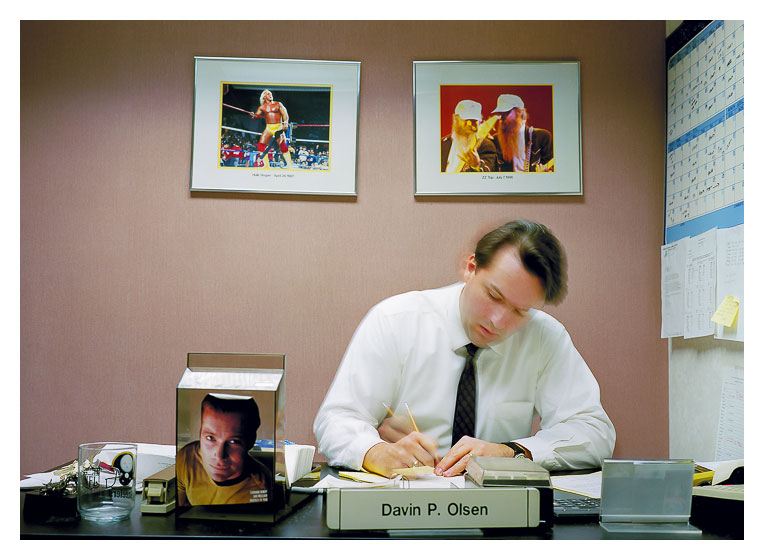
Commercial Bank, New Haven, Connecticut © Steven Ahlgren
When I'm not buying photo books, I'm a compulsive purchaser of old photography magazines. There is so much inspiration to be found in the glossy pages of back issues and every once in a while you find hidden gems by a photographer you've never heard of before. This past winter I bought a copy of the summer 1997 issue of DoubleTake and had one of those wonderful moments of discovery. The photographer was Steven Ahlgren and the work was from a series examining workplace environments.
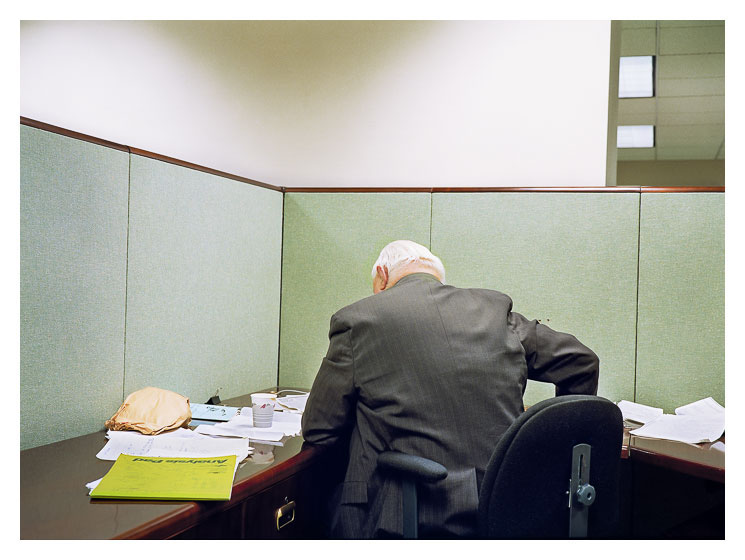
Accounting Office, New Haven, Connecticut © Steven Ahlgren
What immediately struck me about Steven's photographs was they seemed like they could have been made last week. I went straight to Google to find as much information as I could about his work and career since the piece in DoubleTake. Funny thing was, Steven Ahlgren was nowhere to be found. There was no portfolio site, no recent news stories about exhibitions and no blog posts about this amazing photographer. The only mention I could find was a 1993 New York Times review for a show at the International Center of Photography. The ICP show featured names like Cindy Sherman, Laurie Simmons, Richard Prince, Barbara Norfleet, John Pfahl and Lee Friedlander, but the Times paid special attention to Steven's photographs saying they had a "somber and evocative directness."I dug a little deeper and found a notice for an Introduction to Digital Photography course taught by a Steven Ahlgren at the Media-Upper Providence Library in Media, PA. I emailed the librarian explaining who I was and asking if he could put me in touch with Steven. A week passed and I was beginning to give up hope when I received an email. It was him. He was the Steven Ahlgren I was looking for.
Steven's work had blown me away and I wanted to learn more about his process, but I was also curious how a photographer of such obvious talent found himself on the outside looking in at the contemporary photography scene. I asked Steven if he would be up for a quick interview. I was very happy when he agreed and shared his newly launched portfolio site.

Bullet Holes, Insurance Office, Newark, New Jersey © Steven Ahlgren
AMY STEIN: My journey to photography was very much a reaction to my experience with the corporate world. I found it insulating and uninspiring and decided to shift my career towards something that would excite my interests in the world outside of the glass buildings and cubicles. You came to photography after working as a lending officer at a bank. What was it about the corporate experience that compelled you to come back and capture life amongst the copy machines and fluorescent corridors?
STEVEN AHLGREN: When I left banking after five years I really had no immediate intention of going back to photograph that world. I was frankly kind of bitter about the years I spent behind a desk, thinking it was all wasted time, and I didn't want to dwell on it any further. I did however have many vivid visual memories from the office - of dramatic light in hallways and tense faces at meetings, but still I didn't really consider it as a subject. It was only after a few years went by and I had the opportunity in graduate school to earn extra money photographing "networking" meetings - where business people meet after work socially to exchange cards and make contacts - that I began to think about it as a subject. I had also by that point come across the work of several photographers who had photographed the office that got me thinking about it. I still retained some strong (mostly negative) feelings about the time I worked in offices, and those probably contributed to a desire to try and address it as a subject as well.
My first attempt to photograph the business world was photographing these social events, but I felt the need to make the work more conceptual and more critical. I thought the images needed some help to get their point across so I would also photograph selections from pages of various "how to succeed in business” advice books and combine the images and words in black and white prints. The results were satisfying at the time, but the appeal didn't last. Soon after these images seemed overly satirical, caustic, and simplistic. I realized my feelings toward the office, and also to those people who work in them, were a bit more complicated and sympathetic. So I later dropped the text and wrestled with the much harder task of making meaning with just pictures. I also then decided to switch to color - partly out of an instinct that it was better for the subject, but also because I had not photographed a lot in color up to this point and I wanted an excuse to figure it out by working with it.

Commercial Bank, St. Paul, Minnesota © Steven Ahlgren
I liked these new images better, but soon after I decided that the only way to properly address the topic of office workers was to photograph them in their offices. Getting access was the biggest difficulty, but I continued to attend these networking meetings and ask people if I could make some portraits of them at work for a personal project. I told them they wouldn't have to pose or do anything special. I would only use whatever light was there. Just let me set up a camera and watch them as they kept going about their routine. As you might expect most people would decline, but others were open to it. I first spent a few months using color negative film in the same Leica that I used for the networking meetings, but was never satisfied with the prints. So I bought a 6x9 Fuji and that was the thing that did it for me. Finally with the bigger negative the images began to approximate what I was seeing and feeling in these interior spaces. The quietness of the images seemed more pronounced. The light and color were much more evocatively described. I've always photographed by available light and this larger size negative seemed to work better with this. It was exactly what I was after. I suppose it was a good lesson of the importance of using the proper tool for a particular job at hand.
AS: What I love about your series is that the photographs seem very much of the time and yet very relevant now. Save for some outmoded haircuts and computer equipment, the photographs you took 15 years ago could just as easily been taken last week. The same dead stares at the desk. The same polite unease in a meeting. The same subtle power maneuvering between middle managers. What do you think is it about the office environment that makes the experience so consistent over time?
SA: I guess in part it's because the nature of the work itself hasn't changed much. Office work is still primarily about gathering, analyzing, and sharing information. These days of course that information mostly resides in a computer, which for some reason seems to be one of the few markers of time in an office picture. Office furniture seems curiously impervious to redesign - either in form or color palette. And office work is still done by people with all the forever-inherent complications, tensions, resentments, anxieties, etc. that arise when people are organized into a hierarchy and given a task to accomplish.
I have to mention here as an aside how much my working life has changed since these photographs were made. It's ironic to me that now I spend a good deal of my "photography" time working on the computer, probably not looking much different than one of my subjects. One of the reasons I left banking was because I wanted to spare myself from a lifetime of looking at a computer monitor.

Federal Investigation Agency, Leesburg, VA © Steven Ahlgren
AS: When I see photography about office work I am almost immediately reminded of Lee Friedlander's At Work series. Were you aware of these photographs when you started your series? Which photographers inspired you when you were starting out? Which photographers inspire you now?
SA: As a longtime admirer of Lee Friedlander's work - not only his office photographs but even more so his other subjects - that's nice to hear. Friedlander was one of several photographers who addressed the office as a subject that I admired early on, although when I started my series the only ones of his I had seen was a group of photos he did for MIT that showed various workers staring into their computer monitors. He hadn't yet gotten his Hasselblad with the super-wide lens. The other photographers I saw early on were Chauncey Hare, Dan Weiner and Anna Fox. Hare's book This Was Corporate America (published around 1984 I think) was a sort of confirmation that the subject was worthy of serious exploration. Dan Weiner's book America Worked also served that purpose but with a more sympathetic and subtle take. Anna Fox had some office photos from a series called Workstations published in an issue of Aperture in the late 80's focusing on contemporary British photography and her work remained with me as well. But I should mention that probably the biggest influence on me for these photos was actually done by a painter and not a photographer. Edward Hopper's Office at Night has as long as I can remember been one of my favorite paintings. I love the quiet tension in the image, which shows only a man at a desk and a woman standing nearby.
These days I've been looking at recent work (not of the office) by Michael Schmidt - especially Irgendwo - and also Paul Graham. I've also been looking a lot at Rembrandt's self-portraits - no doubt due to some mid-life thing on my part.
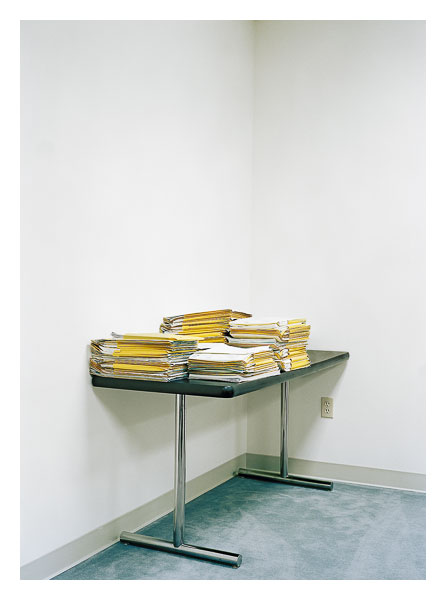
Commercial Bank, Duluth, Minnesota © Steven Ahlgren
AS: Have you seen any of the more recent office projects like Eric Percher's Work or Lars Tunbjork's Offices?SA: I have seen few of Lars Tunbjork's office images. I have not gotten my hands on the book he did of the subject. I like some of them very much, although they seem in a different place than mine. His approach seems a bit more witty and colorful. More Martin Parr-ish. Eric Percher's work, which I had not seen prior to your mentioning it, is likewise rewarding to view. I recently looked at his web site. I am most interested in his still life's.
AS: You worked on Going to Work for most of the early 90's and received a good deal of attention for the series including a group show at the ICP that was reviewed in the New York Times and the feature in DoubleTake magazine. I think most photographers live in a constant state of paranoia that their last success might be their last success. I would love to get a sense of how you viewed your successes at the time. Is that what you were gunning for in your career or were you not even thinking of museum shows and magazine profiles when you first picked up a camera?
SA: I was very happy for the photographs to get the attention and those are the kind of places I had hoped to have them seen and discussed. I hoped it would be the opening of having the work seen more widely, although that was not to be the case - due in part to lack of further positive response from many of those I later showed the work to, as well as a lack of persistence on my part. Hopefully on another go around I can get the work seen in a few more places. Last year I reprinted the portfolio of this work as inkjet prints and I found when looking closely at the work again now that it has (for me at least) weathered time well. As a whole the images still feel true and I find them relevant today. Interestingly many of the images in the series were made when the economy was rapidly growing.
AS: After Double Take you maintained something of a low profile on the photography scene. Where you still taking pictures?
SA: I kept working on it through the 90's and I added to the project by moving outside to explore corporate pedestrians - mostly on Wall Street - in tandem with a group of images of architectural details of corporate office buildings. After working so much inside I think I wanted to get outside in the daylight again. Also these latter two projects didn't require obtaining access. The subjects were there whenever I wanted to work on it. These outside images were only seen once at a now defunct on-line magazine called "word.com". I also started and abandoned several projects - a series on the New Jersey Meadowlands (which someone recently published a book on) and another series on weeds (I think this subject is still virgin territory in terms of a book). Around this time I began doing editorial work since, despite some early success in the art world, I was getting a better response to my work from editors than from curators and galleries. I also found appealing the chance to get paid (more than I was earning adjunct teaching) to travel around the country to make photographs.
Then my personal life changed dramatically in June, 2000 with the birth of the first of my two daughters and the relocation of our family to outside Philadelphia where my wife and I bought a charming yet thoroughly dilapidated old house. Most of my waking hours were soon taken up between tending to the girls and renovating the house to be somewhat habitable - both of which activities I confess to have thoroughly enjoyed. Now however the girls are in school for more of the day and the house, while still needing work, is a bit more under control so I find I can now begin to get back photography again.

Air Intake, Office Building, New York City © Steven Ahlgren
When I did have free time over these past years I spent a good chunk of it trying to figure how to make prints on the computer - kind of relearning photography - which has been a mostly satisfying experience mixed in with periods of extreme frustration. This seems to be the natural order when humans and computers interact. Today I am in the process of completing a web site and beginning to make a maquette comprising and combining all three corporate projects.
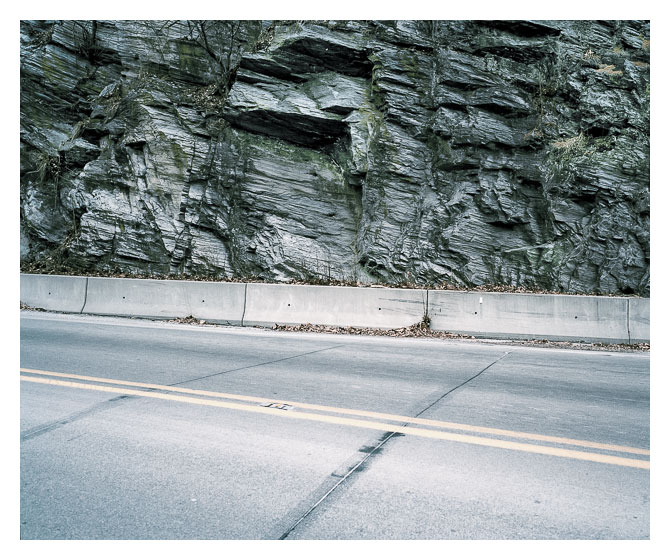
Sidewalk, Wilmington, Delaware © Steven Ahlgren
AS: What's next? Do you have any new work planned?
SA: I've begun working on a series whose tentative title is Autocratic Landscapes. I am fascinated by the primacy of the car and what our fealty to it yields in terms of the landscape we pass through on a daily basis, in addition to how it effects our architecture and our relationships to each other.
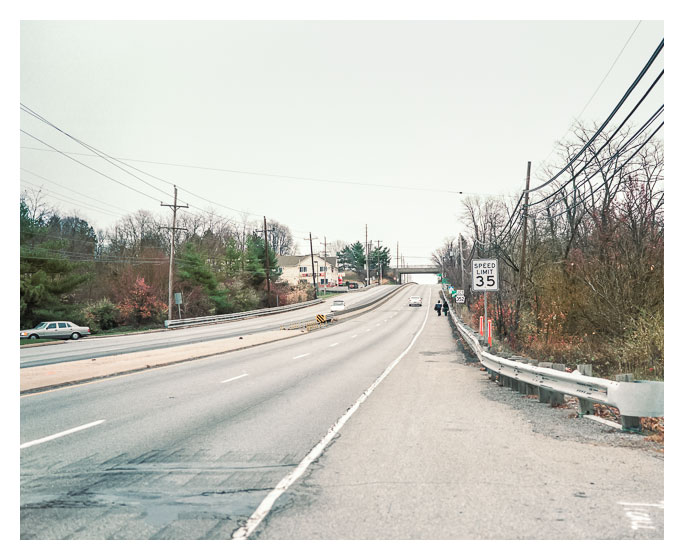
Laundromat, Broomall, Pennsylvania © Steven Ahlgren
AS: Do you have any advice for young photographers?
SA: I was recently reading an essay about Harry Callahan, and there was a recollection by a former student of how he would always say to just go out and do the work, even if your not sure where it's going. Get up and do some work, any work, and something may come of it. Make something and react to what you've made in order to find a path. That seems like pretty good idea.
Another piece of favorite advice, or perhaps it's more of an admonishment, comes from Walker Evans: "Stare, pry, listen, eavesdrop. Die knowing something. You are not here long."
